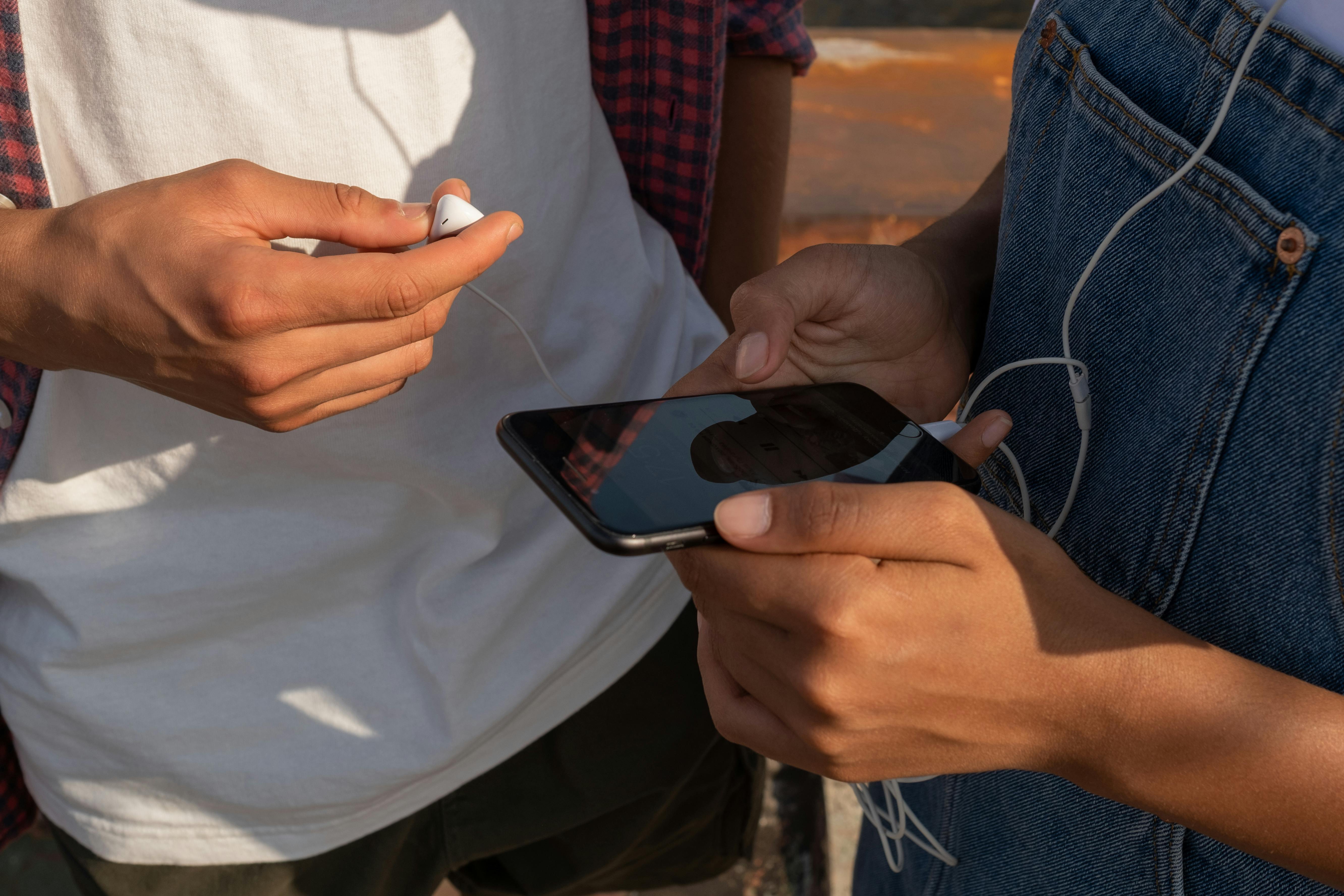So, you wanna know how to easily extract high-quality sound from YouTube videos? Yeah, me too. It’s funny how something as simple as grabbing audio from YouTube feels like you need a PhD in tech wizardry these days. But what if I told you there’s a way to do this without losing your mind—or the sound quality? Enter the world of the YouTube Audio Converter, that magical tool everyone seems to whisper about but no one really explains properly. Why is no one talking about the best ways to convert YouTube videos into crisp, clear audio files? It’s like a secret club for audiophiles and casual listeners alike.
Honestly, I wasn’t expecting much at first, but turns out, YouTube audio converters have come a long way. They’re not just some dodgy sites with endless ads and malware threats, nope. Some of these converters actually deliver high-quality sound extraction, making it super easy to save your favourite tracks or podcasts offline. Maybe it’s just me, but I always thought this would be obvious—click, convert, done. Nope, there’s a bit more to it, like choosing the right format, bitrate, and avoiding those annoying quality drops. What if we’ve been wrong all along about how complicated this had to be? Stick around, because I’m gonna show you how to do this without losing audio fidelity or your sanity.
What Is a YouTube Audio Converter and Why You Need It in 2024
Alright, so here we go — YouTube Audio Converter. Yeah, I know, sounds a bit techy and boring, but stick with me. If you’re like me, you’ve probably been in that awkward spot where you stumble upon a banging track or some podcast gem on YouTube and think, “Hey, I wish I could just rip the audio and listen to it offline, no buffering, no ads, nothing.” Well, that’s basically what a YouTube Audio Converter is for. But why on earth would you still need one in 2024? Aren’t we all streaming everything now? Let’s dive in before I start rambling about my Spotify playlists or how I’m still stuck on dial-up speeds sometimes.
What Is a YouTube Audio Converter Anyway?
Simply put, a YouTube Audio Converter is a tool—usually an app or a website—that lets you extract just the sound from a YouTube video. Instead of downloading the whole video (which takes up loads of space and bandwidth), it grabs just the audio track, converts it to a format you want (like MP3, WAV, or AAC), and saves it to your device.
Sounds simple, right? But it’s a bit more nuanced — especially in 2024, when quality matters and everyone’s paranoid about copyright laws (more on that later). Anyway, these converters come in all shapes and sizes: some are free, some paid, some dodgy, and some legit. Honestly, it’s a minefield out there.
Why You Probably Still Need One in 2024
Okay, so here’s where I start questioning my life choices. Seriously, who even came up with this? Streaming’s everywhere, Spotify’s got everything… but for some reason, YouTube Audio Converters remain popular. Why? Well, here’s the lowdown:
- Offline listening: Not everyone has unlimited data or Wi-Fi all the time. If you’re commuting, travelling, or just avoiding those annoying ads, having audio files saved locally is a lifesaver.
- Sound quality control: YouTube compresses audio for streaming, which can sound a bit meh. Some converters let you extract audio in higher bitrates, meaning better quality if you’re picky (or just weird like me).
- Creating personal playlists: Maybe it’s just me, but sometimes YouTube’s recommendations are rubbish. Downloading audio means you can curate your own playlists without relying on YouTube’s algorithms.
- Content creation: For podcasters, DJs, or video editors, ripping audio snippets for remixing or reference is a thing. Not that I’m condoning anything illegal, but you get the gist.
Honestly, it’s not just a “download music” tool anymore; it’s kinda become a Swiss Army knife for audio geeks and casual users alike.
YouTube Audio Converter: How To Easily Extract High-Quality Sound
Alright, listen, this is where things get a bit messy. I’ve tried a bunch of these things over the years, and not all are created equal. Some convert in seconds, others take ages, and some just crash and burn (ugh). Here’s a rough guide on how to actually get good sound out of YouTube videos:
- Find the video URL: This is the bit where you copy the link from the YouTube video you want.
- Pick a reliable converter: Look for ones that mention “high-quality” or “320kbps” conversions. Some popular options in 2024 are (not sponsored, just stuff I used): YTMP3, 4K YouTube to MP3, and ClipGrab.
- Paste the URL: Most converters have a simple box where you paste the link.
- Choose the format: MP3 is the usual go-to for compatibility, but WAV or FLAC are better if you care about quality (and have the storage).
- Start the conversion: Hit convert and wait — sometimes it’s almost instant, sometimes you’re left staring at a loading spinner like it’s 1999.
- Download and enjoy: Once done, save the file and play it on your device of choice.
Here’s a quick table to compare common audio formats you might see:
| Format | Quality | File Size | Compatibility |
|---|---|---|---|
| MP3 | Good | Small | Almost all devices |
| WAV | Excellent | Large | Professional use, PCs |
| AAC | Better than MP3 | Medium | Apple devices favoured |
| FLAC | Lossless | Large | Audiophiles and Hi-Fi gear |
Not rocket science, but if you’re anything like me, picking the right format is a struggle. Should I care about file size? Eh, maybe not.
Sorry, had to grab a coffee — anyway…
A Few Warnings (Because Nothing
Top 7 YouTube Audio Converters for Extracting High-Quality Sound Effortlessly
Alright, so here we are again, diving into the wild, weird world of YouTube audio converters. I mean, seriously, who even came up with the idea that you’d wanna rip audio off YouTube videos? Like, isn’t YouTube just for watching cats fall off sofas or conspiracy theories about the moon landing? But nooo, apparently, there’s a whole crowd out there obsessed with extracting high-quality sound from videos. Maybe it’s just me, but this feels like one of those tech rabbit holes where you start with “I want that one song” and end up with a folder full of weird audio files named “Track1_final_real_this_time.mp3”.
Anyway, I’m supposed to talk about the Top 7 YouTube Audio Converters for Extracting High-Quality Sound Effortlessly — so buckle up, grab a cuppa (or a cheeky gin, why not), and let’s get into it.
Why Bother With a YouTube Audio Converter?
Before we get all techy, let’s ask the obvious: why do you even need a YouTube audio converter? Can’t you just listen on YouTube? Sure, but:
- Sometimes you want offline access (hello, dodgy Wi-Fi on the subway).
- Maybe you’re making a playlist for your next party and hate buffering.
- Or you’re working on a project and need that background track without the video.
Also, the quality bit — not all converters are created equal. Some spit out rubbish audio at 128kbps, which sounds like a robot gargling, while others actually nail the original sound quality, preserving those sweet highs and lows. Not really sure why this matters, but audiophiles get weirdly passionate about bitrate and sample rates.
What Makes a Good YouTube Audio Converter?
This is where it gets tricky. Ideally, you want:
- Ease of use: Because who’s got time for clunky software that requires a degree in computer science?
- High-quality output: At least 256kbps or better, if you’re fancy.
- Speed: Ain’t nobody got time to wait 10 minutes per song.
- Format options: MP3, WAV, FLAC — depends if you’re some kind of sound snob.
- No shady ads or malware: This is a must, unless you enjoy your computer getting riddled with viruses.
Top 7 YouTube Audio Converters for Extracting High-Quality Sound Effortlessly
Alright, drumroll please 🥁… Here’s a rough list I’ve cobbled together, mixing up personal experience, random internet reviews, and sheer guesswork:
4K YouTube to MP3
- Super straightforward, just paste the link and boom, audio.
- Supports up to 320kbps MP3, which is decent.
- Works on Windows, Mac, Linux.
- Occasionally slows down if you batch a million songs.
YTMP3.cc
- Web-based, no downloads, which is a blessing or a curse.
- Supports MP3 and MP4 but sometimes quality drops.
- Annoying ads, so be ready to click close 10 times.
- Not great for long videos (over an hour).
Freemake Video Converter
- It’s a bit of an all-rounder, converts videos and extracts audio.
- Free version slaps a watermark, which is annoying.
- Decent quality, supports multiple formats.
- Windows only, I think.
Any Video Converter (AVC)
- More than just a YouTube converter, good for bulk jobs.
- Supports 320kbps MP3 and lossless formats.
- Interface feels old-school but works.
- Free version has some limitations.
ClipGrab
- Open-source and fairly simple to use.
- Allows choosing audio formats and quality.
- Occasionally crashes on big files.
- Good for the tech-savvy who don’t mind a bit of fiddling.
Y2Mate
- Another web-based converter, quick and dirty.
- Supports multiple audio formats.
- Beware of pop-ups and dodgy ads.
- Quality is okay but don’t expect miracles.
TunesKit Audio Capture
- Premium, but if you’re serious about audio, it’s worth a look.
- Captures any sound playing on your computer — so it’s like a recording method.
- High-quality output, supports editing.
- Probably overkill if you just want a quick MP3.
How To Easily Extract High-Quality Sound With a YouTube Audio Converter
Okay, so the process is usually pretty similar across the board, but here’s the ultimate cheat sheet:
- Find the You
Step-by-Step Guide: How to Convert YouTube Videos to MP3 with Superior Audio Quality
Step-by-Step Guide: How to Convert YouTube Videos to MP3 with Superior Audio Quality (Because Why Not?)
Alright, so you’ve stumbled upon this whole YouTube-to-MP3 thing, right? Maybe you just want to snag that one song from a random vlog, or you’re like me, hoarding podcasts and lectures to listen offline when the Wi-Fi’s playing hide-and-seek. Whatever the reason, converting YouTube videos to MP3 isn’t exactly rocket science—but if you’re picky about audio quality (and who isn’t, really?), it’s a bit trickier than just hitting “download” on some dodgy site.
First off, a quick heads-up: YouTube’s terms and conditions don’t exactly give you a thumbs-up to download content without permission. But hey, that’s the internet for ya, full of grey areas and “educational use” claims. I’m not here to get you in trouble, just sharing how it’s done, so maybe keep it legal-ish, yeah?
Why This Still Matters (Even in 2024)
You might think, “Why bother with MP3s when streaming’s everywhere and data’s cheap?” Fair point, mate. But here’s the thing — sometimes you want your tunes or lectures without buffering, no ads, and no data munching on the go. Plus, some of us like organising files, creating playlists, or just being old-school digital hoarders.
Also, audio quality is a big deal. You don’t want your favourite track sounding like it was recorded through a tin can, and that’s where a good YouTube audio converter comes into play. It’s not just about ripping sound; it’s about extracting it in the best possible quality.
What Is a YouTube Audio Converter Anyway?
In the most basic sense, a YouTube audio converter is a tool or software that takes a YouTube video and lets you save the audio portion as an MP3 (or other audio formats, but MP3’s king). Sounds simple, but there’s a catch: YouTube videos come in all kinds of quality, from low-res rants to crystal-clear music vids, so the converter has to handle all that without turning your audio into a mushy mess.
Some converters do a decent job at keeping the bitrate high (think 320 kbps for superior sound), while others just spit out rubbish. So, picking the right one is like trying to find a decent kebab in Times Square — it’s out there, but you gotta know where to look.
Step-by-Step Guide: How to Convert YouTube Videos to MP3
Right, let’s get down to brass tacks. Here’s a straightforward process you can follow. This assumes you’re on a PC or Mac and don’t want to install dodgy software that might be packed with malware (seriously, who even came up with this?).
Find the YouTube Video URL
Go to the YouTube video you want, copy the URL from your browser’s address bar. Simple enough.Choose a Reliable YouTube Audio Converter
There’s loads out there, but some popular ones include:- 4K Video Downloader (desktop app)
- YTMP3.cc (web-based)
- OnlineVideoConverter.pro
- FLVTO.biz
Pro tip: Desktop apps usually give better quality and more control, but web converters are quick for a one-off job.
Paste the URL into the Converter
Most sites or apps have a clear box to paste the link. Do that.Select MP3 as the Output Format
Some tools offer various bitrates (128 kbps, 192 kbps, 320 kbps). Pick the highest for superior audio quality.Hit Convert or Download
Wait for it to process. This can take a few seconds to a couple of minutes, depending on video length and your internet speed.Download the MP3 File
Save it somewhere sensible on your device. Maybe a folder called “Music I Swear I’ll Listen To.”Enjoy (Or Question Your Life Choices)
Pop those wireless headphones on and revel in your freshly minted MP3.
What’s This Bitrate Business About?
Bitrate is kinda like the “resolution” for audio. Higher bitrate means better quality, but also bigger file sizes. Here’s a quick table to clear the fog:
| Bitrate (kbps) | Quality Level | Typical Use |
|---|---|---|
| 128 | Low | Podcasts, voice memos |
| 192 | Medium | Casual listening |
| 256 | High | Audiophiles on a budget |
| 320 | Very High (Best) | Music lovers, serious ears |
Honestly, if you’re using
Best Practices for Using a YouTube Audio Converter Safely and Legally in the UK
Alright, so you’re here because you wanna know about YouTube audio converters, right? Maybe you stumbled on one of those dodgy websites promising to “convert your vids to MP3 in seconds, no catches!” — yeah, we’ve all been there. But before you go wild downloading your favourite tunes or that podcast episode you missed, let’s have a proper chinwag about the best practices for using a YouTube audio converter safely and legally in the UK. Because, honestly, who wants to end up on the wrong side of the law or get their computer riddled with malware? Not me, and probably not you either.
Why Bother With a YouTube Audio Converter Anyway?
YouTube is this massive treasure trove of audio content, from music tracks to interviews, lectures, and all sorts. Sometimes, you just wanna extract the sound without the video – maybe to listen offline, make a playlist, or even for a project (educational or otherwise). Sounds simple, right? But here’s the kicker: YouTube itself doesn’t really encourage ripping audio off their platform. Their terms of service are pretty clear that downloading content without permission isn’t kosher. So, yeah, it’s a bit of a grey area.
But, and here’s the twist, there are legitimate reasons and ways to use a youtube audio converter legally in the UK. Like, if it’s your own content, or if you have explicit permission from the copyright holder. Or when the content is actually in the public domain. Confusing? Absolutely.
The Legal Side of Things in the UK (Because You Don’t Wanna Get Busted)
I mean, the UK’s copyright laws are kinda strict but also… flexible? Sort of. The Copyright, Designs and Patents Act 1988 is the main piece of legislation here, and it basically says you can’t just nick copyrighted stuff without permission. But, there are exceptions like “fair dealing” for private study, research, or criticism. Still, downloading entire tracks just because you fancy them probably doesn’t cut it.
Here’s a quick rundown:
- Do use converters for your own content or stuff with Creative Commons licences.
- Do not convert and distribute copyrighted music or audio without permission.
- Don’t use converters that force you to download malware or sketchy software.
- Try to stick to reputable sites or apps with good reviews.
- Remember that even if it’s “just for personal use,” it can still be a legal no-no.
Honestly, this whole copyright thing is like walking on eggshells – you wanna enjoy content but don’t want to end up in hot water.
YouTube Audio Converter: How To Easily Extract High-Quality Sound (Without Going Mental)
Right, so assuming you’re not a criminal mastermind out here illegally ripping off every song, how do you actually get high-quality audio from YouTube? Because, let’s be honest, some converters butcher the sound, and you’re left with this tinny mess that sounds like it’s coming through a tin can and string.
Here’s how to do it without losing your mind:
- Choose the right converter: Look for tools that let you select output quality. I’m talking 320 kbps MP3 or even lossless formats if possible.
- Check the source video quality: If the original video is low-res, your audio won’t magically improve.
- Avoid converters with sketchy ads: Some websites bombard you with pop-ups and fake download buttons. Just no.
- Use browser extensions cautiously: Sometimes they’re handy but can be malware magnets.
- Test the output: Always play the converted file before deleting the original or relying on it.
Just a heads-up, not all converters are created equal. Some free ones are like that dodgy kebab shop on the corner – cheap, but you might regret it later.
Quick Table: Popular YouTube Audio Converters vs Features
| Converter | Output Quality Options | Ease of Use | Legal Caution | Malware Risk |
|---|---|---|---|---|
| YTMP3.cc | Up to 320 kbps MP3 | Very easy | Needs user discretion | Medium |
| 4K Video Downloader | High-quality, lossless | Moderate | Legal with own content | Low |
| ClipGrab | MP3 and others | User-friendly | Fair use in some cases | Low |
| OnlineVideoConverter | Various formats | Simple | Risky, check copyright | High |
(Sorry if this table looks a bit messy, I’m half asleep here.)
Best Practices for Using a YouTube Audio Converter Safely and Legally in the UK (Because You’re Not a Pirate, Right?)
- Always read the terms of service of both YouTube and
How to Extract Lossless Audio from YouTube Videos: Tips for Audiophiles
Alright, so you want to know how to extract lossless audio from YouTube videos? Sounds fancy, right? Like you’re some kind of audio wizard or something. Honestly, I get it. YouTube’s got tonnes of stuff, from live gigs to podcasts, and sometimes you just wanna rip that sweet, sweet sound without losing any quality. But here’s the kicker — is YouTube even giving you lossless audio to begin with? Spoiler: mostly, no. But hey, let’s not get ahead of ourselves.
Why Even Bother About Lossless Audio from YouTube?
Okay, first off, lossless audio means the sound quality is preserved exactly as the original recording — no compression artefacts, no dodgy muffled bits. Audiophiles swear by it. But YouTube? It’s typically streaming compressed audio — usually AAC or Opus formats, at bitrates that are decent but nowhere near lossless. So, if you’re expecting to get FLAC-quality from a YouTube video, you might be setting yourself up for disappointment.
Still, some people swear by “youtube audio converters” that claim to rip audio in the best way possible. And hey, sometimes you just want a quick and dirty way to save that track you love from a video, even if it’s not 100% pristine. So yeah, there’s a niche for this.
The Basics: What is a YouTube Audio Converter?
In the simplest terms, a YouTube audio converter is a tool — usually a website or software — that lets you download and convert the audio track from a YouTube video into an MP3, WAV, or sometimes even FLAC file. Sounds straightforward, but the devil’s in the details.
Some converters just grab the compressed audio stream directly, so you’re basically copying what YouTube is already compressing. Others try to “upscale” or “enhance” the sound, which honestly is a bit of a scam — you can’t make bad quality sound good just by tweaking it.
Quick Table: Common Audio Formats You’ll See
| Format | Compression | Quality | File Size | Ideal Use |
|---|---|---|---|---|
| MP3 | Lossy | Good | Small | General listening |
| AAC | Lossy | Better than MP3 | Small | Streaming, podcasts |
| WAV | Lossless | Excellent | Large | Editing, archiving |
| FLAC | Lossless | Excellent | Medium | Audiophiles, backups |
YouTube usually streams in AAC or Opus — both lossy. So even if you convert to WAV or FLAC, you’re not magically getting better sound — just a bigger file. Weird, right?
How To Actually Extract High-Quality Sound From YouTube
Here’s the rub: you want the highest quality audio YouTube offers. That means grabbing the audio stream at the highest bitrate possible — usually 160 kbps or 256 kbps depending on the video. Not lossless, but decent.
Step-by-step (ish):
- Find a reliable youtube audio converter. Some popular ones: 4K Video Downloader, YTMP3, or even desktop apps like Audacity with plugins.
- Paste the YouTube video link.
- Choose the audio format — MP3 is common, but if you want “lossless” vibes, pick WAV or FLAC if available.
- Hit download and wait a bit.
- Play the file on your favourite player.
Easy, right? But wait, there’s a catch— not all converters are trustworthy, some are riddled with ads or malware. Seriously, who even came up with this whole shady converter business?
Audiophile Tips: Getting the Best Out of Your Downloads
- Check the source video quality: If it’s a low-res upload, even the best converter won’t save you.
- Use desktop apps over browser sites: They tend to be safer and offer better options.
- Don’t expect miracles: YouTube compresses audio heavily; you can’t get CD-quality from a 128 kbps stream.
- Consider alternative sources: Sometimes the artist has official downloads or Spotify offers better quality streams.
Side Note: Legal Stuff (Because You Know We Have To)
Downloading audio from YouTube is kinda a grey area legally. YouTube’s terms forbid downloading unless there’s a download button, but people do it anyway. Not saying you should break the law, but, well, it happens. Maybe stick to stuff you have permission to use?
Sorry, had to grab a coffee — anyway…
Right, where were we? Oh yeah, converting audio. One thing that bugs me is how some converters claim “lossless extraction!” and then you get a dodgy MP3 with background noise. Like, mate, don’t fake it. It’s not that hard
Comparing Free vs Paid YouTube Audio Converters: Which One Delivers the Best Sound?
Alright, so you’re here because you want to figure out the deal with YouTube audio converters, right? Like, how on earth do you get that sweet sound out of a YouTube vid without mucking it all up? And more importantly, is it better to go free or pay for one of these converters? Honestly, I’ve been down that rabbit hole more times than I care to admit—and spoiler alert: it’s not as straightforward as you’d think. But hey, let’s dive in and unravel this mess together, shall we?
Comparing Free vs Paid YouTube Audio Converters: Which One Delivers the Best Sound?
First off, what even is a YouTube audio converter? Basically, it’s a tool—either an app or online service—that lets you rip the audio track from YouTube videos and save it as an MP3 or other file formats. Seems simple, right? Well, not always. The quality of the sound you get can vary, and that’s where this whole free vs paid debate kicks off.
Here’s the thing: free converters are, well, free. They usually do the job, but sometimes the output sounds a bit… meh. You might get lower bitrate audio, annoying ads, or worse, the converter botching the file so it sounds like a strangled cat. Paid converters, on the other hand, promise higher quality sound, faster processing, and fewer headaches. But do you really need to splash the cash? Let’s break it down.
| Feature | Free YouTube Audio Converters | Paid YouTube Audio Converters |
|---|---|---|
| Cost | Zero, nada, zilch | Usually £10-£50 depending on the software |
| Audio Quality | Often limited to 128–192 kbps bitrate | Up to 320 kbps or lossless options |
| Ads and Pop-ups | Usually present, sometimes obnoxious | Generally ad-free |
| Speed | Slower, especially with large files | Faster, better optimisation |
| Extra Features | Basic extraction only | Batch downloads, format conversion, editing |
| Security Risks | Varies; some sketchy sites can have malware | More trustworthy, regular updates |
Honestly, if you just want a quick clip for a meme or something, a free converter might do. But if you’re after quality—like proper high-fidelity stuff for a podcast or remix—then maybe shelling out a bit is worth it.
YouTube Audio Converter: How To Easily Extract High-Quality Sound
Okay, before I forget, here’s a quick rundown on how you actually do this extraction thing without losing your mind (or your hearing):
- Choose your converter: Pick one of the popular ones. Some free favourites are YTMP3, 4K Video Downloader (has a free tier), or ClipGrab. Paid options include Audials, Wondershare UniConverter, or something like iTubeGo.
- Copy the URL: Go to the YouTube video you want and copy its link from the address bar.
- Paste it into the converter: Most tools have a simple input field where you drop in the URL.
- Select output format and quality: MP3 is the usual, but some converters also do FLAC or WAV if you want lossless (and if your wallet’s feeling generous).
- Hit convert/download: Easy as that. Wait a bit, depending on the file size and your internet speed.
- Check your file: Always listen to it once downloaded to make sure it’s not totally trashed.
If you want the best sound, aim for at least 256 kbps bitrate, preferably 320 kbps. Anything lower and you’re basically settling for radio quality, which might be fine for some, but a nightmare for audiophiles.
Quick History Tidbit (Because Why Not?)
Did you know that back in the early 2000s, ripping audio from videos or DVDs was a right hassle? You had to download clunky software, fiddle with codecs, and pray nothing crashed. YouTube audio converters only really took off when YouTube exploded in popularity around 2007-2010, and people started wanting to save music videos or podcasts offline. Since then, the tech’s improved loads but also got more complicated because of copyright rules and all that jazz.
Sorry, had to grab a coffee — anyway…
Right, where was I? Oh yeah, you might wonder if using these converters is even legal? Well, that’s a murky pond. Downloading audio from YouTube for personal use might fly under fair use in some places—but sharing or profiting from it definitely doesn’t. So, don’t go around acting like a pirate, yeah?
Why This Still
The Ultimate Guide to Downloading YouTube Audio Files on Windows and Mac
Alright, so you’re here because, like me at 2am, you’re trying to figure out how to download audio from YouTube without losing your mind or your sound quality. Honestly, who hasn’t been there? You want that one podcast episode, or maybe it’s a chill lo-fi playlist, and you just need the audio file on your Windows or Mac machine. So here’s the thing: despite the endless tools and, frankly, dodgy websites promising the moon, getting high-quality audio files isn’t always straightforward. But fear not—I’ll try to make this as painless as possible, or at least give you some clarity before you rage-quit.
Why This Still Matters (Even if You’re Not a Tech Geek)
Okay, first off, why bother extracting audio from YouTube videos? Well, it’s not just about “pirating” or whatever the legal folks might say. Sometimes you want offline access, or you’re working on a project that requires just the sound—like sampling, remixing, or maybe you’re a teacher who wants the audio for lessons without buffering issues. Plus, let’s be real, internet can be spotty; having the audio file saved locally can be a lifesaver.
Historically, YouTube started as a video-sharing platform, but over time, people realised the treasure trove of sound that lives there. Back in the early 2010s, audio converters were rudimentary, often resulted in crappy quality or malware. Fast forward to now, and there are some decent tools—though you still gotta watch out for sketchy ads and pop-ups. Seriously, who even came up with those “download now!” buttons that lead you to who-knows-where?
What is a Youtube Audio Converter Anyway?
In the simplest terms, it’s a software or online service that extracts the audio track from a YouTube video and saves it as a file on your computer, usually in MP3 or WAV format. But here’s the kicker: not all converters are created equal. Some butcher the sound quality, others limit the length or the number of downloads, and a few try to sneak in malware (because why not?).
The good ones will let you:
- Choose the audio format (MP3, AAC, WAV, etc.)
- Select bitrates for quality (128 kbps, 320 kbps, etc.)
- Convert videos from both Windows and Mac without fuss
- Batch download multiple files (if you’re feeling ambitious)
How To Easily Extract High-Quality Sound (Without Losing Your Mind)
I’m gonna lay out the basics for both Windows and Mac, because yes, the process can differ slightly. Not really sure why this matters, but I guess it’s the little OS quirks that mess things up.
Step-by-step for Windows:
- Find your YouTube video and copy the URL. Easy.
- Pick a reliable YouTube audio converter. Some popular ones are 4K YouTube to MP3, YTMP3, or ClipGrab. (Heads up: some might be free with ads or have paid versions.)
- Paste the URL into the converter.
- Choose your desired audio format and quality. I usually go for 320 kbps MP3 because who wants low-fi, right?
- Click “Convert” or “Download” and wait. Depending on your internet speed, this could be a minute or three.
- Locate the saved audio file on your PC and, voila, you’re done.
Mac users, you’re not left out!
- You can use similar tools, but sometimes the Mac versions are slightly different or have alternative apps like “AllToMP3” or “MediaHuman YouTube to MP3 Converter.”
- The process is the same: copy URL, paste, pick format, download.
- Mac’s security settings might give you a headache the first time you open these apps—just go to System Preferences and allow the app if it’s from an unidentified developer.
Quick Comparison Table: Windows vs Mac Audio Conversion Tools
| Feature | Windows Tools | Mac Tools |
|---|---|---|
| Popular Apps | 4K YouTube to MP3, ClipGrab | AllToMP3, MediaHuman |
| Ease of Use | Generally straightforward | Slightly trickier security |
| Quality Options | 128 kbps – 320 kbps | Same |
| Batch Downloading | Available | Available |
| Free vs Paid Versions | Both available | Both available |
Sorry, had to grab a coffee — anyway, back to it.
Some Handy Tips and Warnings Before You Dive In
- Always double-check the file format before downloading. MP3 is universal, but sometimes you find weird file extensions that your player won’t recognise.
- Beware of shady websites that scream “
How to Preserve Audio Quality When Converting YouTube Videos to MP3 or WAV
Alright, so here we are, diving into the murky world of ripping audio from YouTube videos — yeah, I know, sounds a bit dodgy, but bear with me. You ever wondered how to preserve audio quality when converting YouTube videos to MP3 or WAV? Like, it’s not rocket science, but somehow everyone ends up with these tinny, distorted sounds that make you question life choices. Seriously, who even came up with this obsession of turning YouTube vids into audio files? Anyway, whatever your reason, let’s try to make the process less painful and, you know, not ruin your favourite tunes.
Why This Still Matters (More Than You’d Think)
YouTube is basically a giant audio-visual soup — mostly video, but the audio side is what people really want when they convert stuff to MP3 or WAV. The thing is, YouTube compresses everything (because duh, bandwidth costs money), so the original audio is already not exactly studio quality. But when you convert it poorly, it just gets worse, like trying to photocopy a photocopy of a blurry photo.
If you’re not careful, you’ll end up with:
- Muffled sound
- Loss of bass or treble
- Annoying background noise
- Weird artefacts (those little pops and clicks that make you wanna scream)
Not really sure why this matters, but audiophiles swear by WAV files because they’re lossless — no compression, just raw data. MP3s are compressed, but if done right, they’re decent enough for casual listening.
YouTube Audio Converter: How To Easily Extract High-Quality Sound
Right, so you want a “YouTube audio converter” that doesn’t make your ears bleed. Good luck, because there are gazillion options out there, from shady websites that look like they were designed in 2003, to software that demands you install a million toolbars. Ugh.
Here’s a quick rundown of what to look for:
- Supports High Bitrate – Aim for 256 kbps or higher for MP3; 44.1 kHz sampling rate is the bare minimum.
- Offers WAV Format – If you want pristine sound, WAV is your friend. It’s huge in size though, so be ready for that.
- No Forced Compression – Some converters automatically downgrade your audio to save space, which is rubbish.
- Batch Conversion – Useful if you’re downloading a playlist or multiple tracks.
- Simple Interface – Because who’s got time to figure out complicated menus at 2am?
Quick Table: MP3 vs WAV When Extracting YouTube Audio
| Feature | MP3 | WAV |
|---|---|---|
| File Size | Small to Medium | Large |
| Audio Quality | Lossy Compression | Lossless (Better Quality) |
| Compatibility | Almost all devices | Mostly PCs and media players |
| Ideal Use | Casual listening, portable | Professional editing, archiving |
| Conversion Speed | Faster | Slower (bigger files) |
Honestly, if you’re converting for something casual, MP3 at 320 kbps is fine. If you want to be all fancy and serious about it, WAV is the way to go — but you’re gonna need storage space like you wouldn’t believe.
Step-by-Step Notes on Preserving Audio Quality
Okay, now the nitty-gritty, how to actually do this without your ears bleeding:
- Pick a Trustworthy Converter – I’m talking about ones like 4K Video Downloader, YTMP3, or similar reputable tools. Avoid those weird pop-up-ridden sites.
- Choose the Right Format – Always pick WAV if you want no quality loss, or MP3 320 kbps if you’re lazy and want smaller files.
- Never Convert Multiple Times – Like, don’t convert a YouTube video to MP3, then convert that MP3 to WAV. That’s double trouble.
- Check the Original Audio Quality – Some videos are uploaded at 128 kbps or worse; no converter can fix rubbish source audio, mate.
- Don’t Use “Fast” or “Low Quality” Settings – They’re tempting to save time but end up trashing the sound.
- Listen Before You Save – If possible, preview the audio before finalising.
Oh, Hold On — Had To Grab a Coffee, You Know How It Is…
Right, where was I? Oh yeah, the software! Another thing — some YouTube audio converters claim to be “free” but hit you with hidden ads or spyware. Always have your antivirus on, and maybe consider paid options if you’re serious about quality. I mean
5 Common Mistakes to Avoid When Using a YouTube Audio Converter
Ever tried ripping audio from YouTube and ended up with some dodgy, scratchy mess that sounds worse than your mate’s garage band? Yeah, me too. You’d think using a YouTube audio converter to extract high-quality sound would be straightforward, right? Nah, it’s like navigating a maze blindfolded—loads of pitfalls and facepalms along the way. So, here’s a cheeky rundown of 5 common mistakes to avoid when using these so-called magical converters. Because honestly, who has time for rubbish audio? Not me, that’s for sure.
Why YouTube Audio Converters Are Actually Useful (Sometimes)
Before I dive in headfirst with the rant, let’s get this straight: YouTube audio converters can be a lifesaver if you want to snag a podcast, a lecture, or that one song you can’t get out of your head (don’t judge). They strip the audio from video files so you can listen offline, save space, or just have a neat little MP3. But, and this is a big but, not all converters are created equal. Some will butcher the sound quality, others might be riddled with ads, and a handful might even sneak in malware (seriously, who even came up with this?).
Anyway, what was I saying again? Oh, right, mistakes. Let’s crack on.
5 Common Mistakes to Avoid When Using a YouTube Audio Converter
Ignoring the Audio Quality Settings
This one’s a classic. You’d think the default settings would be decent, but nope. Many converters default to lower bitrates, like 128 kbps, which sounds like you’re listening through a tin can. For proper, crisp sound, always aim for 256 kbps or higher (320 kbps if you’re feeling fancy). Not really sure why it matters, but apparently, it makes a difference. Like, your ears will thank you later.Using Shady or Untrusted Websites
Look, your mum probably warned you about dodgy sites, and she was right. Some free YouTube audio converters might look legit but will bombard you with pop-ups, or worse, install sketchy software on your computer. Always stick to reputable converters—there are plenty out there that won’t try to rip you off or ruin your laptop.Downloading Copyrighted Content Without Permission
Okay, this one’s important but also a bit of a grey area. YouTube’s terms basically say “don’t download unless you have permission.” So, technically, ripping music or videos without consent is a no-no. Maybe it’s just me, but I try to keep it legal-ish and stick to content that’s clearly free to use. You know, like royalty-free tracks or your own uploads.Not Checking the File Format
Ever ended up with a weird file extension that your phone or media player won’t recognise? Yeah, happens all the time. Most converters offer MP3, but some might default to formats like M4A or WAV. If you’re not careful, you’ll have a perfectly good audio file that’s completely useless on your favourite device. Just double-check before you hit that download button.Forgetting to Scan the File After Download
This is less about audio quality and more about sanity. Sometimes, those pesky converters sneak in malware or viruses. Always run your downloads through antivirus software. Seriously, do it. Not really sure why it matters, but better safe than sorry, right?
YouTube Audio Converter: How To Easily Extract High-Quality Sound
Alright, enough doom and gloom—here’s a simple step-by-step to get decent audio without losing your mind:
- Find a reputable YouTube audio converter (some popular names include YTMP3, 4K Video Downloader, or ClipGrab).
- Paste the YouTube URL into the converter’s input box.
- Choose the audio format, ideally MP3.
- Set the audio quality to 256 kbps or 320 kbps (if available).
- Hit “convert” and wait.
- Download the file and scan it with antivirus software (because yeah, we just went over that).
- Transfer it to your device and enjoy.
Simple, right? If only everything in life was this straightforward.
Quick Comparison: Popular YouTube Audio Converters
| Converter | Quality Options | Ads/Pop-ups | Platform Support | Ease of Use |
|---|---|---|---|---|
| YTMP3 | Up to 320 kbps | Lots of ads | Web-based | Very easy |
| 4K Video Downloader | Up to 320 kbps | Minimal ads | Windows, Mac, Linux |
Can You Convert YouTube Videos to Audio Without Losing Quality? Expert Answers
Can You Convert YouTube Videos to Audio Without Losing Quality? Expert Answers, YouTube Audio Converter: How To Easily Extract High-Quality Sound, youtube audio converter
Alright, so here we are, late at night, pondering the great mysteries of life… like, can you actually convert YouTube videos to audio without losing any of that sweet, sweet quality? I mean, seriously, who even thought this would be a thing people care enough about to Google at 2am? But hey, apparently it matters, especially if you’re like me and just want to listen to that podcast or song offline without the video hogging all your data. So buckle up, because this might get a bit all over the place (because, well, I’m tired and a bit annoyed by all these half-baked converters out there).
Why This Still Matters (More Than You’d Think)
If you’re anything like me, you’ve probably tried to rip audio off YouTube videos at some point. Maybe it was a live set from your fave DJ, or that TED talk you wanted to listen to while pretending to work. Problem is, most converters make you choose between “fast but rubbish” or “slow but kinda okay”. And losing quality? Yeah, that’s the real kicker.
Here’s the deal: YouTube compresses its videos and audio to save bandwidth. The audio you get streaming is often compressed to around 128 kbps or 192 kbps (sometimes 256 kbps for music videos). That means it’s not lossless to begin with. So if you’re expecting CD-quality or FLAC-quality audio off YouTube, you’re kinda dreaming. But if you want to keep what’s there, you can totally do that — just don’t expect miracles.
What Is a YouTube Audio Converter, Anyway?
In case you’re not hip to the jargon, a YouTube audio converter is basically a tool (usually an online website, app, or software) that takes the video URL and extracts the audio track from it. Simple, right? But the devil’s in the details — how it does that, what format it spits out, and whether it slaps on some extra compression or not.
You’ll find converters that output MP3, WAV, M4A, and even FLAC sometimes. MP3 is the most common, but it’s also lossy (meaning it throws away some audio data to make files smaller). WAV and FLAC are lossless, so they keep more audio fidelity — but guess what? If the source audio on YouTube is compressed down to 128 kbps, converting it to FLAC won’t magically add detail that isn’t there. It’s like photocopying a photocopy and hoping it looks brand spanking new.
How to Extract High-Quality Sound From YouTube Videos (Step-By-Step-ish)
Okay, now for the practical bit. You want to extract audio without losing quality. Here’s my messy, semi-organised guide:
Find a reliable YouTube audio converter.
Not all sites are trustworthy, and many bombard you with ads or malware. Some popular ones (as of now) include YTMP3.cc, 4K YouTube to MP3, and ClipGrab. But beware — they change all the time.Choose the right format.
If quality’s your thing, pick WAV or M4A over MP3 if the option exists. MP3 is fine for casual listening but not for audio nerds.Select the highest available bitrate.
Some converters let you choose 128, 192, 256, or 320 kbps. Always go with the highest. Though, again, remember you’re limited by what YouTube streamed.Download and check the file size.
If it’s suspiciously small, chances are the quality is rubbish. Bigger files usually mean better quality (or just bigger, no promises).Use dedicated software for better results.
If you’re serious, apps like 4K Video Downloader or Audacity (with plugins) can extract and convert with more control.
Quick Comparison Table: Common Audio Formats From YouTube Converters
| Format | Compression Type | Typical Quality | File Size | Good For |
|---|---|---|---|---|
| MP3 | Lossy | Up to 320 kbps | Small | Everyday listening |
| M4A | Lossy (AAC) | Up to 256 kbps | Small | Better than MP3 for same size |
| WAV | Lossless | Original stream | Large | Editing, archiving |
| FLAC | Lossless | Same as source | Large | Audiophiles, preserves data |
Sorry, Had to
How to Use YouTube Audio Converters on Mobile: A Complete Tutorial for iOS and Android
How to Use YouTube Audio Converters on Mobile: A Complete Tutorial for iOS and Android
Alright, so you’ve stumbled upon this article probably because you want to extract some sweet tunes or maybe a podcast from a YouTube video, but on your mobile. Not your laptop. Because, you know, who uses laptops anymore? Anyway, YouTube audio converters have been a lifesaver for many, and honestly, they’re kinda tricky to wrap your head around at first. But don’t fret — I’m here to try and break it down without sounding like a robot or a tech manual (which, let’s be honest, I barely understand myself sometimes). So, how do you use YouTube audio converters on mobile devices, be it iOS or Android? Let’s dive in and maybe, just maybe, you’ll walk away feeling like a pro.
Why You Even Need a YouTube Audio Converter
First things first, why bother? YouTube’s great for videos, obviously, but sometimes you just want the audio. Maybe it’s that one podcast episode, or a song that’s nowhere else online, or even an audiobook. Sure, you could just stream it, but what if you’re on a dodgy connection or want to save on data? That’s where YouTube audio converters come in. They let you rip out the sound and save it as an MP3 (or other formats) so you can play it offline. Handy, right?
But wait — before you get all excited and download the first app you see, there’s a catch. Not all converters are created equal, and some might mess up the quality or worse, be full of malware or sketchy ads. Not really sure why that’s still a thing in 2024, but here we are.
YouTube Audio Converter: How To Easily Extract High-Quality Sound
Okay, so quality matters. You don’t want some tinny, robot voice when you’re trying to enjoy your fav tune. Most converters offer different quality settings — like 128 kbps, 192 kbps, or the golden 320 kbps. The higher the kbps, the better the audio. But of course, the bigger the file size too. So if you’re low on storage, maybe compromise a bit.
Here’s a quick rundown of the typical process on mobile:
- Find a reliable YouTube audio converter app or website: There are loads out there. Some popular ones are YTMP3, 4K Video Downloader’s mobile version, or apps like Documents by Readdle on iOS paired with online converters.
- Copy the YouTube video URL: Go to the YouTube app, click share, then copy the link.
- Paste it into the converter: Open your chosen converter app or website and paste that URL.
- Choose your audio format and quality: Usually MP3 is your go-to for compatibility.
- Hit convert and wait: This can take a few seconds to a couple minutes depending on your connection.
- Download the audio file: Once done, save it to your device or cloud storage.
And boom, you’ve got your audio. Simple enough, but the devil’s in the details.
iOS vs Android: Different Strokes for Different Folks
Now, here’s where things get a bit messy. iOS is famously strict about what apps can do, so you can’t just download any random YouTube audio converter from the App Store. Apple’s rules are all about protecting copyrights (or at least that’s what they say). So, many iPhone users have to use a workaround:
- Documents by Readdle method: This app has a built-in browser. You visit an online YouTube converter website, paste the link, convert, and then download the MP3 directly into Documents. From there, you can save it to your Music app or Files. It’s a bit clunky but it works.
- Shortcuts app: Some folks create or download shortcuts that automate the whole process. Honestly, this is a bit above my pay grade, but if you’re tech-savvy, it’s worth exploring.
Android users, on the other hand, have it easier. Since you can install apps from outside the Play Store (if you’re brave enough to allow it), there are more dedicated apps that handle the job with fewer hoops. But, beware — not all third-party apps are safe, so maybe do a bit of digging before installing random APKs.
Sorry, had to grab a coffee — anyway…
Right, where were we? Oh yeah, the nitty-gritty of actually choosing the right converter. It might sound simple, but trust me, you’ll find yourself drowning in ads, pop-ups, and “Download Now!!!” buttons that totally don’t do what they say. Seriously, who even came up with this user experience nightmare?
Anyway, here are some tips to
Exploring the Latest Features in YouTube Audio Converters for 2024
Alright, so here we are, diving headfirst into the weird and wonderful world of YouTube audio converters in 2024. I mean, who even thought we’d be obsessing over these little tools, right? But here we are, trying to figure out how to get that sweet, sweet sound out of YouTube videos without losing our minds—or the quality. Honestly, you’d think it’s a simple task, but nope, there’s a whole labyrinth of features, codecs, and whatnot to wade through. So, strap in (or don’t, I’m not your mum), and let’s explore the latest features in YouTube audio converters for 2024. Because apparently, this still matters more than it should.
Why Bother With YouTube Audio Converters Anyway?
First off, let’s get this straight: YouTube itself doesn’t exactly make it easy to just grab the audio from a video, especially if you want it in decent quality. You could, of course, just play the video and record the sound with some dodgy app, but that’s like using a spoon to eat soup—you can do it, but it’s messy and kinda pointless.
People use YouTube audio converters because:
- They want to save music or podcasts offline (yep, even when offline streaming is a thing).
- They need audio for projects or presentations.
- They’re just too lazy to find the source files elsewhere (guilty as charged).
- Sometimes, it’s about nostalgia or that one weird remix that only exists on YouTube.
In short, these converters are popular because they bridge a gap that YouTube refuses to close. Not really sure why this matters, but hey, people want what they want.
Latest Features in YouTube Audio Converters for 2024
Okay, so this year, the landscape of these converters has shifted a bit. It’s like every app decided to get fancy, adding bells and whistles that honestly, I’m not sure who asked for. But here goes:
- Higher Bitrate Support: You can now extract audio up to 320kbps or even lossless formats like FLAC. Fancy, huh? This means better sound quality, but honestly, unless you’re some audiophile with gold-plated ears, 320kbps is usually enough.
- Batch Conversion: Because why convert one file when you can queue up 20 and forget about them? Perfect for those marathon YouTube binges.
- Cross-Platform Compatibility: Most converters now work on Windows, Mac, Android, and iOS. So, whether you’re on your phone pretending to work or on your laptop pretending to be productive, you’re covered.
- Integrated Search Functions: Some tools let you search YouTube videos inside the app and convert directly. Bit of a time-saver, but also a privacy nightmare? Maybe it’s just me.
- Ad-Free and No Watermarks: A few converters have moved away from those annoying pop-ups and branding that made you want to throw your device out the window.
- Built-in Audio Editing: Trim, fade, or amplify your audio before downloading. Because we all want to be mini sound engineers now, apparently.
Honestly, it’s a mixed bag. Some features are genuinely useful, others feel like fluff. Seriously, who even came up with this? Anyway, what was I saying again?
YouTube Audio Converter: How To Easily Extract High-Quality Sound
Right, let’s get practical because talking about features is all well and good, but how do you actually do it without losing your sanity?
Step-by-step, here’s the basic process almost every decent converter follows:
- Copy the YouTube URL: Grab the link of the video you want audio from. Easy peasy.
- Paste it into the Converter: Open your chosen converter app or website and stick the URL into the provided box.
- Choose the Audio Format: MP3, WAV, FLAC—pick your poison. MP3 is the usual suspect for compatibility, but WAV or FLAC is better if you want quality.
- Select Bitrate/Quality: This is where you choose how “crisp” you want your sound. Higher bitrate = better quality, bigger file.
- Convert: Hit the button and wait. This is the part that tests your patience.
- Download: Save the file to your device and maybe organise it properly for once.
If you’re after some real-deal quality, aim for converters that support lossless formats. But fair warning, not all videos upload in high quality to begin with, so your converter can only do so much.
Quick Comparison: Popular YouTube Audio Converters in 2024
| Converter Name | Max Audio Quality | Batch Conversion | Platform Support | Extra Features |
|——————–|——————-|——————|———————|
How to Extract Audio from YouTube Playlists: Save Time and Get High-Quality Sound
How to Extract Audio from YouTube Playlists: Save Time and Get High-Quality Sound
Right, so you’ve got this amazing YouTube playlist—maybe it’s a collection of your fave chill tunes, or some podcast episodes you wanna listen to on the go without using up all your data. But then the big question hits: how do you actually extract audio from YouTube playlists without losing your mind or ending up with some dodgy sound quality? Yeah, not exactly rocket science, but somehow it feels like a whole mission. Anyway, that’s what we’re diving into today because apparently, people still don’t know the best way to do this. Seriously, who even came up with this whole playlist audio extraction headache?
Why This Still Matters
You might be thinking, “Why bother extracting audio when I can just stream?” Fair point, but hear me out. Streaming eats your data faster than a toddler demolishing a biscuit tin, and if you’re somewhere with dodgy Wi-Fi (hello, New York subway tunnels), buffering turns into a nightmare. Plus, some folks just want high-quality sound files saved for offline listening or editing. Not really sure why this matters, but maybe it’s just me who likes to have a personal soundtrack for random moments like walking the dog or pretending to work.
And let’s not forget, YouTube’s own app doesn’t exactly make it easy to save playlists offline unless you’re shelling out for Premium. So, the next best thing? Using a YouTube audio converter that can do the job quickly and without turning your playlist into a mess of low-quality MP3s.
So, What’s a YouTube Audio Converter, Anyway?
In the simplest terms, a YouTube audio converter is a tool—usually software or an online service—that lets you take a YouTube video or playlist and pull out just the audio. You get a neat little MP3 or WAV file that you can stash on your phone, laptop, whatever. But, here’s the kicker: not all converters are created equal. Some butcher the sound quality, others are slow as a snail on a cold day, and a few are packed with sketchy ads or even malware (yikes). You gotta pick wisely.
Quick History Lesson: Why Did This Become a Thing?
Back in the day, YouTube was all about watching videos, obviously. But then people started using it as a giant jukebox. Playlists popped up everywhere, and suddenly, folks wanted to listen to just the audio part without the video hogging their data or battery. Enter audio extractors. Over the last decade, these tools evolved from clunky, unreliable programs to slick, user-friendly apps that can handle entire playlists in one go. Still, the legality and YouTube’s terms of service make it a bit of a grey area, so—y’know—use at your own risk.
How to Extract Audio from YouTube Playlists: Step-by-Step (Sort Of)
Here’s the general rundown on how to get your playlist audio without losing your sanity or your files:
- Find a reputable YouTube audio converter. Look for ones with good reviews, ideally that mention playlist conversion.
- Copy the URL of your YouTube playlist. Not just a single video, but the whole playlist link.
- Paste the link into the converter’s input box. Most sites/apps have a clear spot for this.
- Choose your audio format and quality. MP3 is common; WAV is better quality but bigger files.
- Start the conversion. This can take a bit, especially for long playlists.
- Download the extracted audio files. Some converters let you download them all at once, others one by one.
- Organise your files. Rename, tag with titles/artists if you want, because otherwise, it’s a mess.
Pros and Cons of Popular Audio Formats
| Format | Quality | File Size | Compatibility | Best For |
|---|---|---|---|---|
| MP3 | Good | Small | Very High | Everyday listening |
| WAV | Excellent | Large | High | Editing or audiophile use |
| AAC | Better than MP3 | Small | High | Apple devices |
Anyway, what was I saying again? Oh right, quality matters. If you just want tunes on your phone, MP3 is fine. But if you’re planning to do anything fancy, go WAV or at least a higher bitrate MP3.
Interrupting Myself for Coffee (Because Priorities)
Sorry, had to grab a coffee — anyway… back to this madness. Sometimes you might want to download an entire playlist, and some converters only handle single videos. That’s a pain in the backside. It’s worth hunting for one that explicitly says “playlist support” because clicking “
Why Choose a British English YouTube Audio Converter for Perfect Localized Audio?
Why Choose a British English YouTube Audio Converter for Perfect Localized Audio?
Alright, so you’re probably here wondering why on earth you’d bother with a British English YouTube audio converter when, well, isn’t audio just audio? I mean, it’s just sound, right? But nope, turns out there’s a bit more to it, especially if you’re into getting that perfectly localised vibe rather than some generic, soulless audio clip. Seriously, who even came up with this obsession about accents and regional quirks in audio files? Anyway, bear with me — this might be more interesting than it sounds.
Why This Still Matters (More Than You’d Think)
YouTube’s a global beast, and the videos you want to rip audio from might be, say, from a British creator or someone speaking in a really specific UK dialect. Now, if you’re extracting audio for a project — maybe a podcast intro, a video, or even just to have that one catchy tune without the annoying background noise — the last thing you want is to lose the “Britishness” of it. It’s like getting a cuppa tea but someone’s swapped the Earl Grey for cheap supermarket tea bags. Doesn’t quite hit the same, does it?
Here’s a quick rundown of why using a British English YouTube audio converter actually makes some sense:
- Preserves Local Pronunciation & Nuance: The way vowels are shaped, consonants clipped, or even the rhythm of speech changes with British English. A converter tuned for that can keep these intact.
- Cultural Relevance: Some phrases or sounds just don’t translate well if the audio is processed or converted by tools optimised for American English or other variants.
- Better Sound Quality for UK Content: Believe it or not, some converters optimise bitrate and formats better for British English videos, leading to clearer, crisper sound.
- Avoids Weird Accent Distortions: Ever tried listening to a British accent that sounds like it’s been through a dodgy robot voice filter? Yeah, no thanks.
YouTube Audio Converter: How To Easily Extract High-Quality Sound
Okay, so say you’re convinced (or at least mildly curious) about this British English audio converter thing. How do you actually get your hands on one? And more importantly, how do you get decent quality sound out of YouTube without ending up with a garbled mess?
Here’s a rough step-by-step, because honestly, it can feel like a minefield:
- Find a Reputable Converter: There are tons of YouTube audio converters out there, but look for ones specifically mentioning British English support or localisation features. It’s not always obvious, so maybe check reviews or user feedback.
- Paste the YouTube URL: Easy enough. Just copy the link of the video you want audio from and drop it in.
- Choose Your Format: MP3 is standard, but if you’re picky (like me), go for higher quality formats like AAC or WAV if the converter offers it.
- Select Audio Quality: Most tools let you pick bitrate — 320 kbps is solid for most uses.
- Hit Convert & Download: Shouldn’t take long, but patience is a virtue here, especially if the converter’s free and overloaded.
- Check Your File: Listen to the audio and see if it sounds natural, like a Brit just chatted to you over a cuppa, not a robot.
Not really sure why this matters so much to some folks, but hey, audio geeks will be audio geeks. Maybe it’s just me, but I can’t stand when my favourite British podcast intros sound like they’ve been through a dodgy app.
A Quick Comparison Table (Because Everyone Loves Those)
| Feature | Generic YouTube Audio Converter | British English Audio Converter |
|---|---|---|
| Accent & Pronunciation | Often generic, sometimes off | Preserves local accent details |
| Supported Formats | MP3, WAV, AAC (varies) | Usually supports high-quality formats |
| Bitrate Options | Varies, sometimes low | Typically offers 320 kbps or better |
| Cultural Localisation | Rarely considered | Designed to maintain UK-specific audio nuances |
| Ease of Use | Usually straightforward | Similar, but with added localisation features |
| Free vs Paid | Many free options available | Some paid tools might offer better quality |
But Wait… Coffee Break ☕
Sorry, had to grab a coffee — anyway, back to it. Honestly, converting YouTube audio isn’t rocket science but the amount of crap converters out there makes it feel like you’re wading through mud. Sometimes you get lucky, other times you download some dodgy file that sounds like it was recorded underwater by a drunk parrot. Not that I’d know
Troubleshooting Tips: What to Do When Your YouTube Audio Converter Isn’t Working
You ever tried to rip the audio from a YouTube video and then bam—your trusty YouTube audio converter just decides to throw a tantrum? Like, seriously, what’s the deal? You just want your podcast episode or that sick remix, and suddenly it’s like the converter’s gone on holiday. Well, welcome to the club. Let’s unpack the chaos that is troubleshooting a YouTube audio converter when it’s playing up, and maybe, just maybe, figure out how to actually extract high-quality sound without losing your mind (or your afternoon).
Why Bother With a YouTube Audio Converter Anyway?
Look, YouTube’s great for watching cat videos and conspiracy rants, but sometimes, you just want the audio. Maybe it’s a song, a lecture, or some motivational nonsense you want to listen to on your commute—without the video hogging all the data. That’s where a YouTube audio converter comes in handy. It’s supposed to pull out just the sound file—mp3, wav, whatever—so you can keep it on your phone or laptop.
But here’s the kicker: not all converters are made equal, and sometimes they’re about as reliable as a soggy biscuit. Plus, YouTube keeps changing its techy bits, so converters gotta keep up or get lost in the dust. Not really sure why this matters, but yeah, quality audio extraction is a whole thing. You want crisp sound, not some tinny mess that sounds like it’s been recorded in a tin can.
Troubleshooting Tips: What to Do When Your YouTube Audio Converter Isn’t Working
Alright, so your converter’s decided to throw a wobbly. Here’s a quick list of what to try before smashing your laptop or yelling at your screen:
Check Your Internet Connection
Sounds obvious, but sometimes weak Wi-Fi is the culprit. If your converter can’t fetch the video properly, it won’t convert squat.Update the Converter App or Website
These tools get updated to keep pace with YouTube’s own updates. If you’re using some ancient software, it might just be incompatible now.Try a Different Converter
Not every converter is shit, but some are. I mean, seriously, who even came up with this? There are loads of free options online—try a few to see if one actually works.Clear Your Browser Cache
If you’re using an online converter, your browser might be holding onto old data that’s mucking things up.Check the Video URL
Sometimes the problem’s as simple as a broken or private link. You can’t convert what you can’t access.Disable VPN or Proxy
Some converters don’t play nice with VPNs, so try switching them off temporarily.Look Out for Copyright or Regional Restrictions
YouTube blocks certain videos from being downloaded or converted due to copyright laws. If it’s not working, maybe it’s not your fault.
Here’s a quick table of common problems and quick fixes:
| Problem | Possible Cause | Quick Fix |
|---|---|---|
| Converter won’t load | Poor internet or server issues | Check connection, wait a bit |
| Output file is corrupt | Conversion interrupted | Try another converter |
| Low audio quality | Converter settings or source | Adjust output format, try WAV |
| Video URL not accepted | Private/restricted content | Use a public video URL |
| Conversion stuck at 0% | Browser cache or VPN issues | Clear cache, disable VPN |
YouTube Audio Converter: How To Easily Extract High-Quality Sound
So, you’re not just about getting any audio. You want it crisp, clear, and maybe something that doesn’t sound like it was recorded on a potato. Here’s the lowdown on how to actually get that done without too much faff.
Choose the Right Converter
Not all converters output the same quality. Look for ones that allow you to pick formats like MP3 with 320 kbps or lossless formats like WAV or FLAC.Understand Bitrate
The bitrate is basically how much data is used for the audio each second. Higher bitrate = better sound, but bigger file. Most folks don’t need more than 320 kbps for MP3s.Use Desktop Software Instead of Online Tools
Online converters are convenient but often limit quality or file size. Desktop apps (like 4K YouTube to MP3 or similar) usually give better control and higher quality.Check the Original Video Quality
If the YouTube video itself is low quality, your audio won’t be any better. No magic converter will fix a rubbish source.Don’t Forget Metadata
Conclusion
In conclusion, a YouTube audio converter is an invaluable tool for anyone looking to easily extract and enjoy audio content from videos. Throughout this article, we explored the convenience of converting YouTube videos into various audio formats such as MP3, the user-friendly interfaces of popular converters, and the importance of choosing reliable and safe platforms to protect your device from malware. Additionally, we highlighted how these converters support offline listening, making your favorite music, podcasts, and audiobooks accessible anytime, anywhere. Whether you’re a music lover, content creator, or simply want to save data by listening offline, using a YouTube audio converter can significantly enhance your media experience. As always, ensure you respect copyright laws and use these tools responsibly. Ready to simplify your audio downloads? Explore trusted YouTube audio converters today and transform the way you listen to online content!







































































